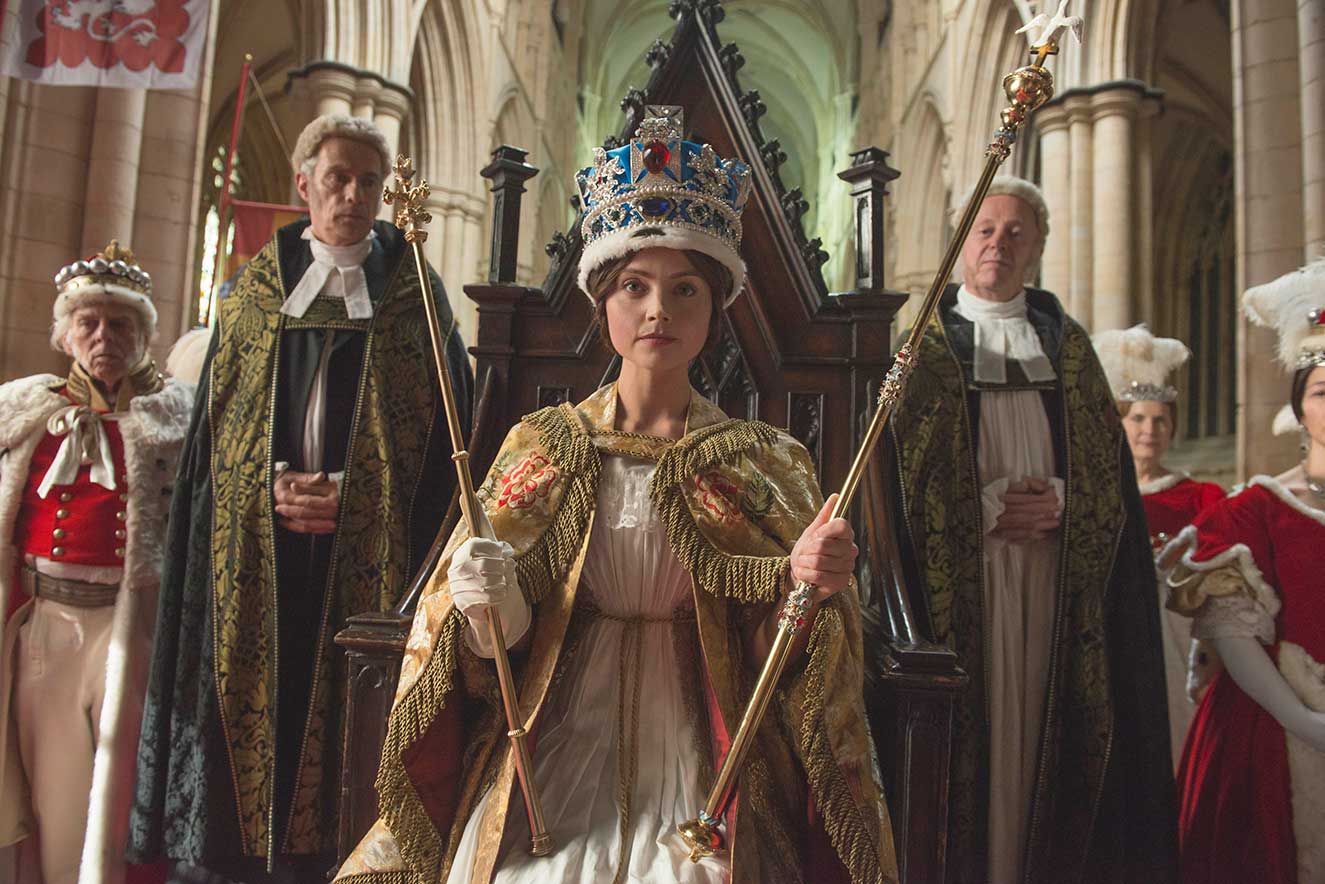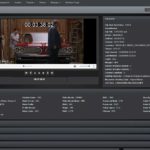
Victoria’s Secrets
Posted on Jan 4, 2017 by Julian Mitchell
How do you make a Sunday night UK period drama look different from the rest? DOP John Lee and colourist Dan Coles had some definite plans.
The ITV/Mammoth Screen production, Victoria, couldn’t have had better pre-publicity than the furore over lead actor Jenna Coleman being too beautiful for the part. This is a Sunday night period drama after all, you don’t want ‘ugly’ before the Monday morning drudge – just look at the Poldark ‘bare chest’ count for further proof.
With this in mind, DOP John Lee set out his plans and kit with colourist Dan Coles coming on board to decide on a look that would transport us to a TV version of the Victorian royal household. The camera combination was ARRI AMIRA and ALEXA Mini, a winning one according to John, more to do with both of them taking a 3D LUT and being able to change frame rates and not drop out of ProRes 4:4:4.
We asked John Lee about his shot selection and beautiful close-ups that reminded us of the movie Brooklyn, shot by Yves Bélanger. “Really the shot selection decisions are made in the edit suite with the three directors we have over the episode blocks. We tried to develop the style as we went along. At the start of the series Victoria is almost imprisoned in Kensington Palace and we tried to incorporate that in the framing to keep a sort of stillness and composition that added to that. Then as she finds her freedom we tried to allow the camera to gain its freedom. It was subtle and you shoot to cover it, you shoot the scene in a way that you feel works and then they sit down and decide how they want the style to progress, they make a lot of those decisions later on – it’s all a collaboration and everyone tries to get the mood of it from the script all the way to the final edit.”
 DOP John Lee and Director Ollie Blackburn.
DOP John Lee and Director Ollie Blackburn.
Amira Mini Combo
John eschewed the standard ARRI ALEXA for the newer AMIRA and ALEXA Mini mainly because of the tiny carriages which royalty usually rode in – not much room for a cameraman with full camera rig. “We were on ARRI AMIRAs and ALEXA Minis with Panavision Primo lenses. The AMIRA was definitely my choice and the lighting design stuff was down to me as well – obviously in discussion with the director and the production designer. Michael Howells and I spent a lot of time working out how to make the sets not look too much like sets. Buckingham Palace was partly sets and partly rooms in stately homes around Yorkshire, so trying to maintain a style that can work from location to studio is always right in the back of your mind.
“The beautiful thing about the ARRI range as opposed to other digital cameras is the way that it can hold the highlights, so you can allow the frame to overexpose because you know that it will bloom and look lovely like it would have with a film camera. The older or different digital cameras don’t have that, they clip and they feel very digital as soon as you’ve got too much contrast. So it allows you to go for more contrast and it doesn’t really make any difference to the power of the lights. Say you’re on a location. You’ve got the sun outside, so you’re competing with that, and that decides the size of the lamps coming through the windows and you’re working back from that. So if you want to create shape you’ve got to overpower what’s already there.
“We did supplement the lighting and shot with natural light. If it was a short enough scene we could control it for the amount of time that we needed to. If you knew the scene was only two or three shots and you were going to get it done in an hour, then you could roll the dice and say what the world is giving us is perfect. The way I like to light is to enhance natural light. I don’t particularly want to make it feel lit but I want to make it feel that you’ve walked into the room at the perfect time of day on a perfect day so it’s as beautiful as natural light can be.”
Some of the rooms in places like Castle Howard were huge and difficult to manage. In the Victorian era apparently they didn’t have much furniture, hence huge empty rooms. John has some clever ways to bring the rooms ‘in’. “We used smoke ‘atmos’ in the air to create depth through shafts of light otherwise the room becomes just a big open space. We did some tests on it and if you just have the light coming through without the smoke then you didn’t get a sense of depth through the lighting – you must have something there to give you the scale of it. There was maybe a bit more smoke than there would have been but the night shots definitely would have had candle smoke and smoke from the fires; some of it is poetic licence because it looks nice.”
 Lighting control on-set.
Lighting control on-set.
Amira, the film camera!
John and Dan managed to come up with a look that harked back to film times. “The AMIRA has a natively 5600K sensor so I did some tests with colourist Dan Coles and normally you would change the white-balance for night and day. But after the tests I treated the AMIRA like a film camera with daylight stock in – when you shot with daylight film stock you would use an 80 filter which is a blue filter that does the white-balance for you. So you’re not doing the white-balance digitally, you’re doing it optically – we did that the whole way through. Even on our candlelit night stuff we were doing it with an 80 filter in front so that we weren’t changing the sensor from its native colour setting. All you’re doing by changing the white-balance is putting gain in to the blue channel, and so you’re losing information and you’re not treating the sensor as it natively should be treated. We found that especially with the candlelit stuff we shot the sensor at 5600K, changed it optically and got a beautiful effect.
“The Primos are fast but you’re losing about a stop and a half depending on which blue filter you use. So it meant putting a little bit more light in. The light on the faces is mostly done by us and the light on the set is done by the candles, we didn’t want the whole image flickering, so I kept the light on the faces as a constant, so it wasn’t a distraction with the candlelit shot. Hopefully that worked as it was a big part of our test. My gaffer brought over a light from America called a birdcage, it’s like a ball but can fit in a smaller space so we could supplement the candles with this or with the spring ball depending on what we could fit in and what worked for the shot.”

Face look
When you have an ARRI AMIRA and ALEXA Mini in your hands shooting a Sunday night drama you can’t miss out on beautiful skin tones, actor Jenna Coleman was a welcome recipient. “For diffusion we were using Black Satins from Tiffen which basically soften off shadows but don’t affect the mid tones and the highlights too much. So we used diffusion filters depending on the shot, if it’s heavily backlit we’d take it out. We’d sort of work it like that, so that hopefully we kept it to a subtle level but we softened it out and took the digital edge off the ALEXA Mini. There’s so much information with the ALEXA Mini that it’s quite nice to soften it off a little, not very much because the Primo lenses are relatively soft anyway. They are very cinematic lenses and the drop-offis gorgeous; it doesn’t take much and the AMIRA’s got quite a soft image, it’s very subtle.
“We had an ARRI AMIRA and a Mini mainly because we were in the carriages and they were tiny. We needed a Mini to do handheld stuff in the carriages. The AMIRA and the Mini match better than the ALEXA and the Mini. They both take a 3D LUT and you can go to a higher frame rate without dropping out of ProRes 4:4:4. I think the AMIRA/ALEXA Mini combo has taken over that style of shooting. I’d say the AMIRA is the most versatile in the ARRI family. The other thing I like about it is the new internal NDs which are the IR NDs. The IRs you put in front on the mattebox often make greens go very green and digitally green. The new internal NDs don’t do that, so you use them for major shifts and use straights NDs to fine-tune.
“For support rigs we did a lot with Steadicams; I like a gimbal but for me I only go to it when a Steadicam won’t work. A Steadicam operator who has been doing it for years, knows his rig and can get something better framed, better composed – it’s just tried and tested. Gimbals have a place but it’s as a tool for a specific job rather than using it all the time. That’s just a personal choice. We had a crane there, a little GF-8 which we had most of the time, we did a lot of handheld on dollies with a false floor so we didn’t feel the steps of handheld which helped as well.”

Colourist Upfront
Dan Coles, the colourist, was involved right from prep. On set they had a 3D LUT which he and John created from some test rushes. John says: “On set I was overexposing the AMIRA by about 2/3 of a stop just to maintain the shadows because it holds the highlights so well; that’s good for the shadows. I’d rather over expose by a little bit to see the information in the shadows. It’s not often that you want to pull back a highlight, if you’ve blown it you’ve blown it for a reason. So I’d rather have the information in the shadows to get back. You just get a thicker negative, it’s a bit like overexposing film, in fact we treated it very much as a film camera.
“The LUT he created meant that when we were on set we were looking at something that was close to where we were going to get to with the grade. It meant I could take risks on set and push it. So that overexposure meant I could sit the exposure where I like it but I haven’t got rid of any information in case we want to lift it.”
“With Victoria I became involved in pre-production with DOP John Lee, early in October 2015. It is not always the norm for a post house to be involved in a UK drama pre-production, but John and I had collaborated on an episode of Endeavour, and knowing we’d both be working on Victoria there was a desire to get the best out of our working relationship – creatively and technically.
“Weeks before the shoot began, John shot some camera tests and we looked at them in my grading suite at Technicolor (I use a Baselight as my grading system). We decided to create a specific look for Victoria – after discussing lenses, filtration, and shooting for daylight with an 80 filter to white-balance the footage, along with other key factors such as the period, colour palette and feel of the series (lighting, costumes, sets and locations etc). We set about devising a 3D LUT to be used for on-set monitoring, in the rushes and throughout the editorial process. I’ve done this on a few projects and found this approach to be beneficial to all involved.
“The 3D LUT we created was how we felt Victoria should look – slightly muted with cooler tones in the shadows and a soft, filmic level of contrast. It was a look that allowed pastel tones to be pronounced and skin tones to be slightly pale. This helped John to monitor something pretty close to the final intended look on set, and the vision was there for everyone involved to see. Whilst this was by no means definitive it gave us a very good ballpark-look for how we wanted things to appear in the final grade.
“A lot of UK drama involves a traditional Rec. 709 3D LUT which makes images more contrasty and saturated – although this is not always the best thing to use – particularly in our case where a more specific approach towards the final look had been discussed.
“After further tests we created different looks for various locations. The Buckingham Palace set had a richer, warmer and more opulent feel; whereas Kensington Palace had a more muted and cool feel. The same can be said for the main areas of the palace being richer and more vibrant than the servants’ quarters. It worked well to create a subtle distinction in the grade between the different spaces.
“Exterior locations regardless of whether sunny or dull were generally graded to be fairly colourful and naturalistic, and with more contrast. Skies were occasionally treated separately, depending on what was required.
“Wherever we could we added texture and depth to the sets using grads, shapes and vignettes, selective diffusion, softening and sharpening, as well as occasional grain addition.
“We used a variety of different approaches in the grade – we did not stick entirely with the original look but it proved to be a useful guideline. It was nice to have the opportunity to experiment with different styles, using different levels of contrast and saturation whilst maintaining an authentic period feel. We did as much as we could in the grade to create a seamlessness between many locations, the sets and the VFX, and to further enhance the beauty and reality of our Victorian world.”
Victoria (Series 2) is to return in 2017.







